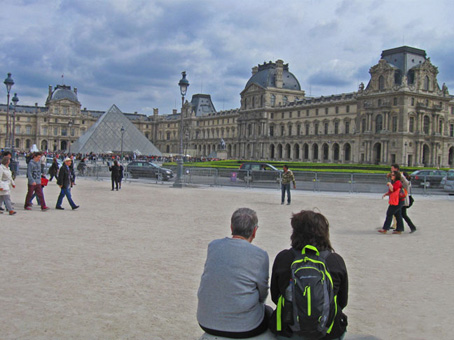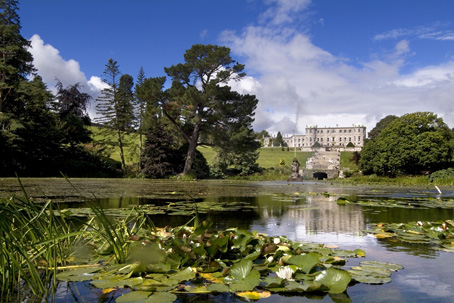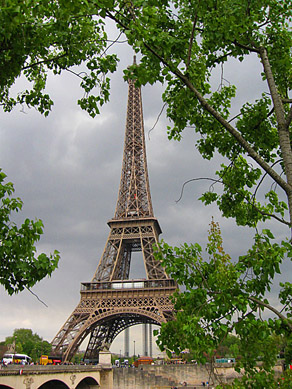

YELLOWSTONE COUNTY MASTER GARDENER ASSOCIATION
A non-profit 501(c)(3) organization.
Europe
Master Gardeners Get Education Overseas
Master Gardeners Joann Glasser and Pat Morrison visited Europe this spring and discovered many exciting gardening treasures on their excursion across the pond. Their ports of call were:
- Dublin Ireland
- Powerscourt House
- London England
- Paris France
Each Port of call has a brief slideshow you can view by clicking on the "SlideShow" Button. Clink on any photo in the slideshow to return to this article.

We'll talk a little about the things Master Gardeners would be interested in and leave out most of the tourist related stuff like how great the Eiffel tower was or how Big Ben sounded and so on.
Traveling to Europe in April can be a little risky as far as the weather goes. Most of the time it is rainy, windy and cold but we were quite lucky and experienced quite mild conditions with virtually no rain or wind for the entire two week trip.
Security checks can be time consuming at some venues such as the airports, the Channel Train at St. Pancras Station in London and entering the Palace of Versailles south of Paris but we did not have any problems. As long as you have recent passports and travel light everything should be OK.
Our travel connections (planes, boats and trains) were flawless, which is quite unusual, so we were able to concentrate on finding awesome plants, trees and gardens. We did!
Dublin
The first stop on our European trip was Dublin, Ireland were we landed after a long but comfortable flight. We found the city easy to navigate only if you did adequate research on the local city bus system which is the only extensive public transportation. Being Master Gardeners, we immediately set out to discover Dublin's horticulture.
Just north of Dublin city center is the expansive and impressive National Botanic Gardens of Ireland.
In 1790, the Irish Parliament made funds available for a public botanic garden and in 1795 the Gardens were founded on lands at Glasnevin.
The original purpose of the Gardens was to promote a scientific approach to the study of agriculture. In its early years the Gardens demonstrated plants that were useful for animal and human food and medicine and for dyeing but it also grew plants that promoted an understanding of systematic botany or were simply beautiful or interesting in themselves.
By the 1830’s, the agricultural purpose of the Gardens had been overtaken by the pursuit of botanical knowledge. This was facilitated by the arrival of plants from around the world and by closer contact with the great gardens in Britain. By 1838, the basic shape of the Gardens had been established.
A development plan for the Gardens, published in 1992, led to a dramatic program of restoration and renewal. Primary amongst these was the restoration of the Turner Curvilinear Range of glasshouses completed in 1995. The ever increasing plant collection and especially plants from tropical areas demanded more and more protected growing conditions so plans were made to develop the iron constructed glasshouse accommodation.
The Botanic Gardens came into state care in 1878 and since then have been administered by various Departments of which the Office of Public Works currently has responsibility.
Within the living collections at the National Botanic Gardens there are over 300 endangered species from around the world, and 6 species already extinct in the wild. The National Herbarium is based within the National Botanic Gardens, and has a collection of nearly 3/4 million dried plant specimens and an active DNA research lab.
The Gardens can easily consume a whole day if you want to see everything. The weather was surprisingly good while we were there in early April and the grounds were not crowded. An amazing array of plants, trees, shrubs, walkways, water features and rock gardens all for a free admission.
Goto SlideshowPowerscourt
Our second stop on our horticultural quest was to one of the few remaining old estates or "country houses" of Ireland. We were able to take a day trip to the gardens at Powerscourt which are situated a few miles south of Dublin in the Wicklow mountains.

The Gardens of Powerscourt were laid out over two main periods. When the house was rebuilt in the decade after 1731, the surrounding grounds were also remodeled. The design reflected the desire to create a garden which was part of the wider landscape. To the North formal tree plantations framed the vista from the house, while a walled garden, fish pond, cascades, grottoes and terraces lay to the South. Walks wound through the wooded grounds and a tree lined avenue was created.
A century later the 6th Viscount Powerscourt instructed his architect, Daniel Robertson, to draw up new schemes for the gardens. Robertson was one of the leading proponents of Italianate garden design which was influenced by the terraces and formal features of the Italian Renaissance villas in France and Germany. Robertson designed the terrace nearest the house.
The son of the 6th Viscount resumed alterations to the gardens in the late 1850s. Using a combination of Robertson’s designs and the plans of the other landscape experts. The terraces were completed, enormous numbers and varieties of trees were planted and the ground adorned with an amazing collection of statuary, ironwork and other decorative items. Further generations of the Wingfields maintained the grounds, adding the Japanese Gardens, Pepper Pot Tower and specimen trees. In 1961 the Estate passed to the Slazenger family, who provided further care and attention.
This estate is simply stunning with its panoramic vistas, immaculately manicured gardens, majestic fountains, secret grottoes and so much more. A treasure trove for gardeners to admire, appreciate and envy.
Goto SlideshowLondon
We traveled to London, England from Dublin crossing the Irish Sea by way of an Irish Ferries mini-cruise. Docking in Hollyhead, Whales we continued to London on train where we were able to take in the Welsh and English countryside at a leisurely pace.
Our main gardening discoveries in London were at the Chelsea Physic Garden which is tucked away in a rather obscure corner beside the river Thames and next to the Royal Hospital. It is a moderate walk from the nearest tube station and we found that many of the local merchants in the immediate area knew nothing of its exact location or even its existence.
This walled Garden was founded in 1673, as the Apothecaries' Garden, with the purpose of training apprentices in identifying plants. The location was chosen as the proximity to the river created a warmer micro climate allowing the survival of many non-native plants - such as the largest outdoor fruiting olive tree in Britain - and more importantly, to allow plants to survive harsh British winters. The river was also important as a transport route that linked the garden to other open spaces facilitating easy movements of both plants and botanists. By the 1700′s it had initiated an international botanic garden seed exchange system, which is still in existence.
Environments for supporting different types of plants were built, including the pond rock garden, constructed from a variety of rock types, namely stones from the Tower of London, Icelandic lava, fused bricks and flint. The structure, completed in 1773, is the oldest public rock garden in England.
In 1876 the Garden initiated a lecture course for young women who were training as botany teachers. At the end of the 19th century the trustees of the City Parochial Foundation agreed to take over the running of the Garden from the Society of Apothecaries. In 1983 the Garden became a registered charity and was opened to the general public for the first time.
The Chelsea Physic Garden plays a major role in public education focusing on natural medicine. The Garden of World Medicine which is Britain’s first garden of ethnobotany is laid out together with a new Pharmaceutical Garden.
Chelsea is more of a quiet and thoughtful scientific destination where you can learn a great deal about horticulture rather than an awe inspiring experience that will knock your socks off. A refreshing change of pace from the hustle and bustle of the typical London tourist sites.
Goto SlideshowParis
Paris, France was the last port of call on our whirlwind European adventure. Unfortunately, we had only two days to explore the city and everything it had to offer. You could easily spend weeks, if not months, and never begin to discover all the fascinating and beautiful treasures.

We decided to see two things: The Palace of Versailles and the Louvre Art Museum.
The Palace of Versailles is about five miles south-east of Paris and can be traveled to easily by way of the Metro/RER subway system. In early April the crowds in Paris were quite intense and sometimes overwhelming. We had to stand in line to get into the Palace Museum for over two hours weaving our way up and down the vast plaza until entering a security search point, single file, before actually gaining entrance.
Visiting the Gardens was equally difficult, and in our case, prohibitive due to the long lines and our exhaustion factor upon finishing the Palace self-guided tour.
After our experience at the Palace of Versailles, we decided we would skip the inevitable long lines at the Louvre and instead simply tour the city on foot starting at the Arch de Triumph. We stumbled upon unexpected treasures everywhere. One can not escape all the incredible monuments, architecture, artwork, gardens, statuary, and fountains which completely surround you.
Tourists surround you as well, so be prepared to endure the crowds. The Metro can get so jam-packed that you may not be able to get off at your stop, which happened to us (but only once). We definitely needed more time to explore. Oh well, maybe next time...
Goto SlideShowVolunteer
About Us
More